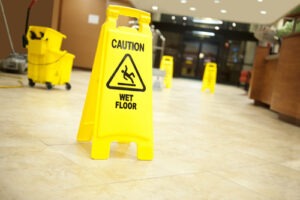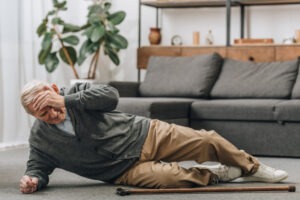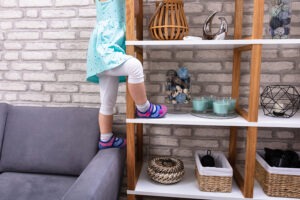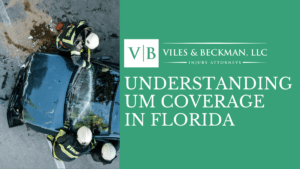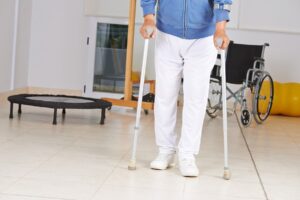
After experiencing a slip and fall accident, healthy young individuals typically only experience minor injuries, if any, and may quickly and fully recover. Elderly individuals, on the other hand, have a high risk of suffering serious injuries or even death as a result of a slip and fall accident. One in four Americans over the age of sixty-five experiences a slip and fall accident each year, accounting for more than 2.8 million injuries and more than 27,000 deaths annually.
Approximately one out of five fall accidents results in the victim sustaining serious injuries, requiring hospitalization or extensive treatment. Nursing home populations typically consist of aging adults with limited independence due to increased frailty and immobility. Individuals in nursing homes have the highest risk of becoming seriously injured in a slip and fall accident. Injured seniors are also more likely to experience difficulties and complications throughout recovery than younger individuals.
Slip and Fall Accidents in the Elderly: The Consequences
As a consequence of a slip and fall accident, elderly individuals may sustain severe injuries. The seriousness of an individual’s injuries depends on the location of the accident and the severity of the fall. Some common injuries resulting from slip and fall accidents include:
Traumatic Brain Injury
Adults over the age of 75 suffer more traumatic brain injuries each year than individuals in any other age group. The majority of traumatic brain injuries in elderly individuals can be attributed to accidents involving falls. Unfortunately, seniors suffering from traumatic brain injuries typically do not heal as quickly or as efficiently as younger individuals with similar injuries.
Many seniors may never fully recover from a traumatic brain injury suffered during a fall and may, in fact, require full-time assistive care following the injury. Individuals who already reside in a nursing home environment when they sustain a traumatic brain injury, often require an increased level of care as a consequence of the injury.
Traumatic brain injuries can interfere with an individual’s cognitive functioning and processing. Many individuals suffering from traumatic brain injuries experience difficulties in maintaining focus and concentration. Traumatic brain injuries may also cause distinct changes in personality and interference with emotional regulation. Disrupted emotional regulation can cause elderly individuals to become easily agitated or withdrawn, and these changes in behavior can be difficult for the victim’s family to understand and accept.
Fractures
Due to normal deterioration associated with aging, seniors sustain bone fractures more easily than other individuals. As individuals age, their bones begin to break down at a higher rate, as the rate of new bone growth decreases. As a result, bones become thinner and more fragile. As individuals increases in age, so does their risk of bone fractures, including broken arms, hands, legs, ankles, and hips.
Seniors suffering from hip fractures may require numerous surgical procedures and long-term hospitalization. Some seniors, especially those with underlying health complications, may never regain the ability to walk after experiencing a serious fracture to their hip.
Lacerations
Elderly individuals often have more fragile skin, which increases the risk of tearing in an accident. In addition, many seniors experience difficulty in maintaining balance as they age which can hinder their ability to avoid landing a fall on a sharp object. Furthermore, as individuals age, the blood loses its ability to clot efficiently, which can lead to significant blood-loss and increased weakness when experiencing a fall.
Death
Due to increased frailty in older individuals, slip and fall accidents can oftentimes lead to death. As mentioned, many elderly individuals experience more bleeding than their younger counterparts, even after sustaining relatively minor injuries. Excessive bleeding and head trauma can lead to death much more quickly in elderly patients. Nursing home patients who suffer serious injuries in a fall have a higher likelihood of death.
Expect More, Receive More: Legal Support That Feels Like Family
Preventing Falls in Nursing Homes
In a nursing home setting, the employees and care providers owe a duty of care to the seniors who reside there to prevent unnecessary danger and suffering. Of course, some falls are unavoidable and occur without warning. However, nursing home staff can implement policies and safety equipment to substantially decrease the risk of residents experiencing a fall.
Nevertheless, individuals in nursing homes have a three times greater risk of suffering a fall than individuals of the same age who reside in the community. Nursing home residents are also ten times more likely to suffer severe injuries as a result of a fall.
Therefore, fall prevention must be a top priority for nursing home administrators and staff, for example:
- Assessing fall risk in each resident. Every resident of a nursing home has a varied risk of falling. Underlying health conditions, for instance, can substantially increase the risk of serious injury from a fall. Nursing home staff should carefully assess the fall risk of each resident and take steps to decrease or prevent those risks, where possible. Care providers should consider the medications each resident is prescribed, along with the resident’s behaviors when assessing individual fall risk. Residents with increased mobility that move about the facility frequently and complete tasks independently, may increase the opportunity and consequently, the risk of experiencing a fall, despite their physical capabilities.
- Providing appropriate footwear. Many nursing homes cannot direct or require residents to wear specific footwear. However, care providers should evaluate residents’ footwear to ensure they have access to shoes that assist with stability and provide needed support, if they want it. Assessing footwear is a simple step that can significantly decrease the risk of a fall.
- Avoiding slippery floors. Slippery floors can be difficult to safely navigate for even the most able-bodied individuals. For seniors with a high risk of slipping and falling, slippery or wet floors can be extremely hazardous. Nursing homes should carefully assess the products they choose for cleaning the floors to decrease the risks of a possible slip and fall accident. Nursing homes may also want to implement policies and procedures for quickly cleaning spills or drying floors after cleaning. Providing clean, dry floor surfaces will ensure that residents can maintain traction as they move about the facility, substantially decreasing the risk of a fall.
- Removing potential trip hazards from the floor. For seniors, especially as balance and dexterity decrease, even seemingly minor obstacles on the floor can significantly increase the risk of a fall. For example, cords running across walkways or rugs that tend to fold and move can create dangerous hazards for elderly individuals. Removing any potential obstacles from floors and walkways will significantly decrease the risks of falling in the facility.
- Placing furniture, including beds and chairs, at the appropriate height. Beds and chairs that sit high off the floor can make it difficult for seniors to regain their footing when they stand up. That imbalance can increase the risk of a fall. Nursing homes should also pay careful attention when securing safety railings on resident’s beds. Seniors may attempt to climb over the rails to exit their beds, increasing the likelihood of experiencing a serious fall.
- Offering mobility aids as needed. Mobility aids can substantially decrease the risk of falls in elderly individuals. Seniors may benefit from the stability provided by a walker or handrail. Handrails often prove to be particularly useful in bathrooms, where floors often become wet and more difficult to safely navigate.
- Providing adequate seating and rest areas. Providing rest areas at various locations throughout the facility allows seniors to sit down and rest as they become weak or unsteady on their feet. Nursing homes should position those rest areas at appropriate intervals, especially in common areas.
- Offering proper training for staff members who must assist seniors in transferring from a bed or a wheelchair. Gait belts can provide critical assistance for staff members when assisting in transferring residents to or from a wheelchair or bed. Supportive devices can provide additional stability, making it easier for staff to safely support residents when transitioning from a bed or wheelchair.
- Keeping an eye on residents who pose a known fall risk. Of course, nursing home staff cannot keep a watchful eye on every resident simultaneously. However, staff should carefully monitor patients with high fall risk, especially those who also suffer cognitive impairments, such as Alzheimer’s or dementia. Decreased cognitive functioning can cause confusion, which may lead senior residents to believe they are more capable of moving about than they actually are.
Nursing homes must acknowledge the potential fall risk that all senior residents face and take steps to prevent those falls as often as practicable. Without proper care and safety measures, nursing home residents may face a greater likelihood of suffering a severe injury in the event of a fall.
What Happens After a Fall in a Nursing Home?
Even in the safest nursing homes, falls may be unavoidable. Sometimes, falls occur despite a lack of fault from nursing home staff or facility conditions. How the nursing home responds, however, can make a big difference in the resident’s recovery.
After a resident experiences a fall in a nursing home facility, care providers should:
- Take the resident for a medical evaluation. Residents should receive an exam from a doctor to ensure that he or she has no broken bones or other complications. Even if a resident is claiming that they are uninjured, a medical evaluation can eliminate any potential head trauma that may not immediately show apparent symptoms.
- Reassess the resident’s fall risk. If a resident previously assumed to have a low fall risk suffers a fall, the nursing home should carefully reevaluate the resident’s fall risk. Thereafter, staff should implement necessary accommodations to account for any increased risk.
- Notify family members. Family members, especially when a family member has power of attorney, should be notified of the accident as soon as possible.
- File an accident report. An adequate accident report must clearly state any conditions that contributed to the fall and any injuries that resulted. In addition, staff should create a thorough record of the resident’s treatment plan pertaining to those injuries.
- Take immediate steps to prevent a recurrence. After a fall, even a fall in which the resident suffered no injury, the nursing home should take immediate steps to prevent future falls. Staff should increase fall prevention provisions throughout the nursing home to ensure other residents do not experience a fall in similar circumstances.
Does the Nursing Home Bear Liability for a Resident’s Fall?
If a nursing home resident suffers a slip and fall in a nursing home, the nursing home may be liable for any resulting injuries.
Nursing home staff may be liable when they fail to provide residents with the required standard of care, including to:
- Ensure a safe living environment for all patients. The nursing home must take steps to decrease slip and fall risk, by providing residents with individualized support and removing any potential hazards.
- Assist residents to help them avoid fall risk. Nursing home staff must provide a high quality of care for each resident, including providing assistance as needed. In some cases, residents experience a slip and fall accident as a result of neglect from nursing home staff. The staff might, for example, leave the resident in bed for too long, leading to a resident trying to get up on his own instead of waiting for assistance. Understaffed facilities may ignore resident’s requests for assistance contributing to an accident causing a fall. Nursing homes should provide physical activities for residents, when possible, to help keep them strong and decrease the risk of a fall.
- Provide immediate medical care to residents who do suffer a fall. If a nursing home ignores a resident’s fall or does not provide adequate medical care following a fall, it can significantly increase the risk of complications. Residents who do not receive immediate care have an increased risk of dying from complications related to their injuries. When nursing homes fail to provide adequate responsive care, residents may endure unnecessary pain and suffering, or increase their risk of a fall in the future.
In some cases, entities outside the nursing home may also bear liability for a patient’s fall. For example, a physician who ignores a patient’s fall risk may increase the resident’s risk of experiencing a slip and fall accident. When nursing homes utilize third party care providers as staff, that provider may also be liable if the staff fails to provide adequate care.
If you or someone you love suffered a fall in a nursing home, an attorney may assist you in recovering compensation. Experienced nursing home lawyers regularly fight for the rights of injured victims to seek the compensation they are entitled to. Contact a nursing home attorney today for a free consultation and case evaluation.

